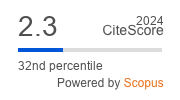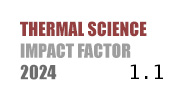THERMAL SCIENCE
International Scientific Journal
EFFECT OF DIFFERENT QUATERNARY BLENDS OF DIESEL-ETHANOL-METHANOL-BUTANOL ON COMBUSTION AND SPRAY CHARACTERISTICS OF DIESEL ENGINE
ABSTRACT
The impact of different diesel-ethanol-methanol-butanol (DEMB) blends on the spray and combustion characteristics of a single-cylinder Diesel engine has been investigated. For this study, commercially available software called Diesel-RK that can predict the spray and combustion parameters has been utilized. Some ex-periments have also been conducted using D100 (100% pure diesel by volume) fuel at a fixed speed of 1500 rpm at peak load while maintaining the same operating conditions as the simulation. The predicted results have been validated against the experimental results obtained with D100. The results of the simulation were found to be in reasonably good agreement with those of the experiment. The analysis of the simulated results shows that the heat release rate, ignition delay and peak cyl-inder pressure increase for all quaternary blends, whereas the peak combustion temperature decreases at low load and increases at higher load. In terms of spray characteristics, the investigations show that quaternary alcohol blends shorten spray tip penetration and increase spray cone angle. Furthermore, as the propor-tion of ethanol and methanol in the DEMB blends increases, the atomized fuel droplets become smaller in diameter and the sauter mean diameter of the blends gradually drops. The authors also suggest that the quaternary blends of this pre-sent investigation have a higher potential to be used as a next-generation fuel in Diesel engine.
KEYWORDS
PAPER SUBMITTED: 2024-02-12
PAPER REVISED: 2024-06-12
PAPER ACCEPTED: 2024-07-01
PUBLISHED ONLINE: 2024-08-31
THERMAL SCIENCE YEAR
2025, VOLUME
29, ISSUE
Issue 1, PAGES [411 - 425]
- Dogan, O., The Influence of N-Butanol/Diesel Fuel Blends Utilization on a Small Diesel Engine Performance and Emissions, Fuel, 90 (2011), 24, pp. 67-72
- ***, International Council on Clean Transportation, theicct.org
- Yao, M., et al., Experimental Study of N-Butanol Additive and Multi-Injection on HD Diesel Engine Performance and Emissions, Fuel, 89 (2010), 9, pp. 2191-2201
- Kar, S., et al., Advances in Catalytic Homogeneous Hydrogenation of Carbon Dioxide to Methanol, Journal of CO2 Utilization, 23 (2018), Jan., pp. 212-218
- Prakash, C. B., et al., The Direct Conversion of Methane to Methanol by Controlled Oxidation, Chemical Reviews, 85 (1983), 4, pp. 235-244
- Dou, Z., et al., Experimental Study of the Effect of Engine Parameters on Ultrafine Particle in Diesel/Methanol Dual Fuel Engine, Fuel, 192 (2017), Mar., pp. 45-52
- Wei, J., et al., Impact of Aluminium Oxide Nanoparticles as an Additive in Diesel-Methanol Blends on a Modern DI Diesel Engine, Applied Thermal Engineering, 185 (2021), 116372
- Kurre, S. K., et al., Experimental Study of the Performance and Emission of Diesel Engine Fueled with Blends of Diesel-Ethanol as an Alternative Fuel, Biofuels, 6 (2015), 3-4, pp. 209-216
- Shadidi, B., et al., The Influence of Diesel-Ethanol Fuel Blends on Performance Parameters and Exhaust Emissions: Experimental Investigation and Multi-Objective Optimization of a Diesel Engine, Sustainability, 13 (2021), 5379
- Padala, S., et al., Ethanol Utilisation in a Diesel Engine Using Dual-Fuelling Technology, Fuel, 109 (2013), July, pp. 597-607
- Chen, H., et al., Investigation on Combustion and Emission Characteristics of a Common Rail Diesel Engine Fueled with Diesel/N-Pentanol/Methanol Blends, Energy, 167 (2019), Jan., pp. 297-311
- Nour, M., et al., Improvement of CI Engine Combustion and Performance Running on Ternary Blends of Higher Alcohol (Pentanol and Octanol)/Hydrous Ethanol/Diesel, Fuel, 251 (2019), Sept., pp. 10-22
- Prabakaran, B., et al., Experimental Investigation of Ethanol-Diesel-Butanol Blends in a Compression Ignition Engine by Modifying the Operating Parameters, SAE, Technical Paper 03-11-05-0037, 2018
- Zhang, Z., et al., Investigation on the Combustion and Emission Characteristics of Diesel Engine Fueled with Diesel/Methanol/n-Butanol Blends, Fuel, 314 (2022), 123088
- Corral-Gomez, L., et al., Effect of Diesel-Biodiesel-Ethanol Blends on the Spray Macroscopic Parameters in a Common-Rail Diesel Injection System, Fuel, 241 (2019), Apr., pp. 876-883
- Mo, J., et al., Experimental Investigation on the Effect of n-Butanol Blending on Spray Characteristics of Soybean Biodiesel in a Common-Rail Fuel Injection System, Fuel, 182 (2016), Oct., pp. 391-401
- Rajesh, Kumar, B., Saravanan, S., Use of Higher Alcohol Biofuels in Diesel Engines: A Review, Renewable and Sustainable Energy Reviews, 60 (2016), July, pp. 84-115
- Kuleshov, A. S., Multi-Zone Di Diesel Spray Combustion Model and its Application for Matching the Injector Design with Piston Bowl Shape, SAE, Technical Paper 2007-01-1908, 2007
- Kuleshov, A. S., Multi-Zone Di Diesel Spray Combustion Model for Thermodynamic Simulation of Engine with PCCI and High EGR Level, SAE, Technical Paper 2009-01-1956, 2009
- Markov, V., et al., Numerical Analysis of Injection and Spray Characteristics of Diesel Fuel and Rapeseed Oil in a Diesel Engine, Case Studies in Thermal Engineering, 35 (2022), 102129
- Atmanli, A., et al., Extensive Analyses of Diesel-Vegetable Oil-n-Butanol Ternary Blends in a Diesel Engine, Applied Energy, 145 (2015), May, pp. 155-162
- Moffat, R. J., Contributions to the Theory of Single-Sample Uncertainty Analysis, Journal of Fluids Engineering, 104 (1982), 2, pp. 250-258

